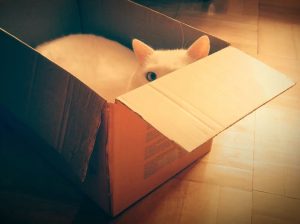Ask any cat: Why do you love curling up in boxes? Then — if the cat deigns to respond — you’re likely to get these sorts of answers:
Because it’s warm and cozy!
Because it makes me feel safe and secure!
Because it’s fun – like a game of high-and-seek!
The experts have a few theories on why cats everywhere do this. Mark D. Freeman, DVM, clinical assistant professor at the VA-MD College of Veterinary Medicine, says the most widely accepted explanation is the security factor. “Cats prefer to have a safe hiding spot from which they can observe the world around them,” he says. Cardboard boxes and other small, confined spaces, fill the bill.
Another reason is that cats find these spaces physically comforting. Curling up in a box reduces whatever anxiety, stress, or fatigue the cat might be feeling. “Boxes can greatly reduce a cat’s stress and help them regulate their body temperatures,” says one expert. And another: “When a cat is overstimulated, tired, or just in need of a break, a box gives them the ability to recharge until they’re ready to come out and play again.” (https://www.rd.com/article/why-cats-love-boxes/ )
Yes, as any cat would agree, life can get uncomfortable, challenging, threatening, and stressful outside of the box. But the reality is – again, just ask a cat – none of us can stay in that cozy box long-term. We must move – and think – beyond it.
Which brings me (at last) to my point: Thinking outside of the box — stepping out of one’s comfort zone (box) and seeing things from a new perspective.
Since about the 1950s, I recently learned, something called the nine-dots puzzle has been widely used to illustrate the phrase “thinking outside of the box.”
In 1969 American Protestant clergyman and best-selling author (The Power of Positive Thinking) Norman Vincent Peale, wrote an article for The Chicago Tribune, which read in part:
“There is a puzzle you may have seen. It’s a drawing of a box with some dots in it, and the idea is to connect all the dots by using only four lines. You can work on that puzzle, but the only way to solve it is to draw the lines so they connect outside the box.
“It’s simple once you realize the principle behind it. But if you keep trying to solve it inside the box, you’ll never be able to master that particular puzzle.
“That puzzle represents the way a lot of people think,” Peale continued. “They get caught up inside the box of their own lives. You’ve got to approach any problem objectively. Stand back and see it for exactly what it is. From a little distance, you can see it a lot more clearly. Try and get a different perspective, a fresh point of view.”
It seems to me this wise counsel is needed more now than ever. And not just for whatever major problems or personal puzzles we may be facing in our lives, but for everyday challenges as well. Snoozing in our little cardboard boxes (comfy old habits) may be nice from time to time (especially at nap time), but we must wake to the reality that the world desperately needs creative thinkers en masse now, who ask urgent questions, beginning with the words “How…?” and “Why…?” and ending with, “What can I do to help?”
Ask any cat and it’ll tell you, lolling in a cardboard-box-hideaway is really fun, but you can’t do it ALL the time. The real world beckons.




